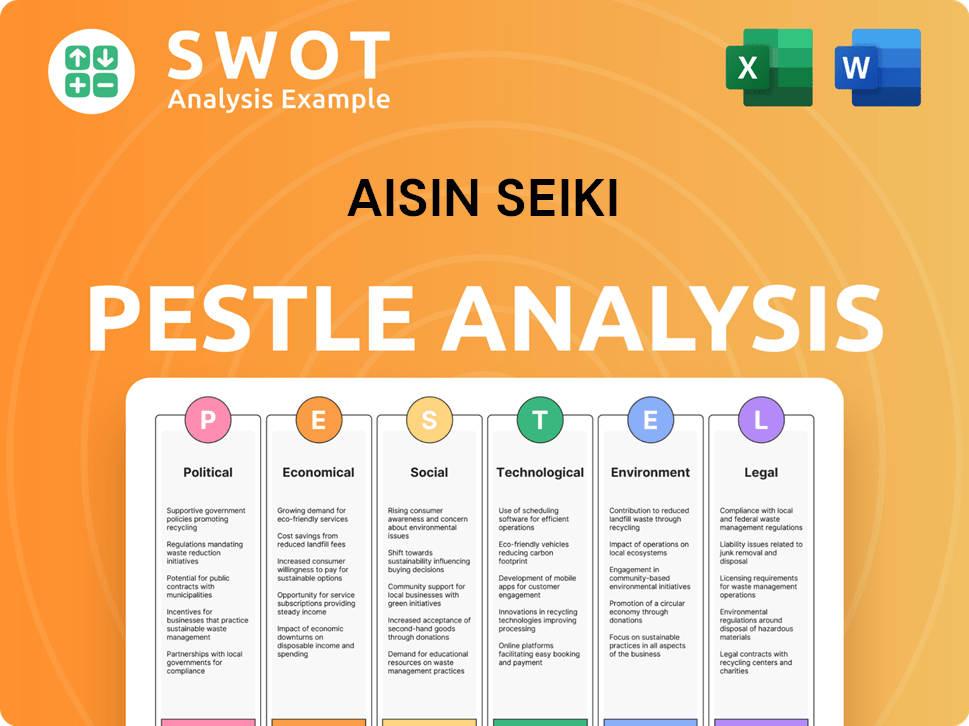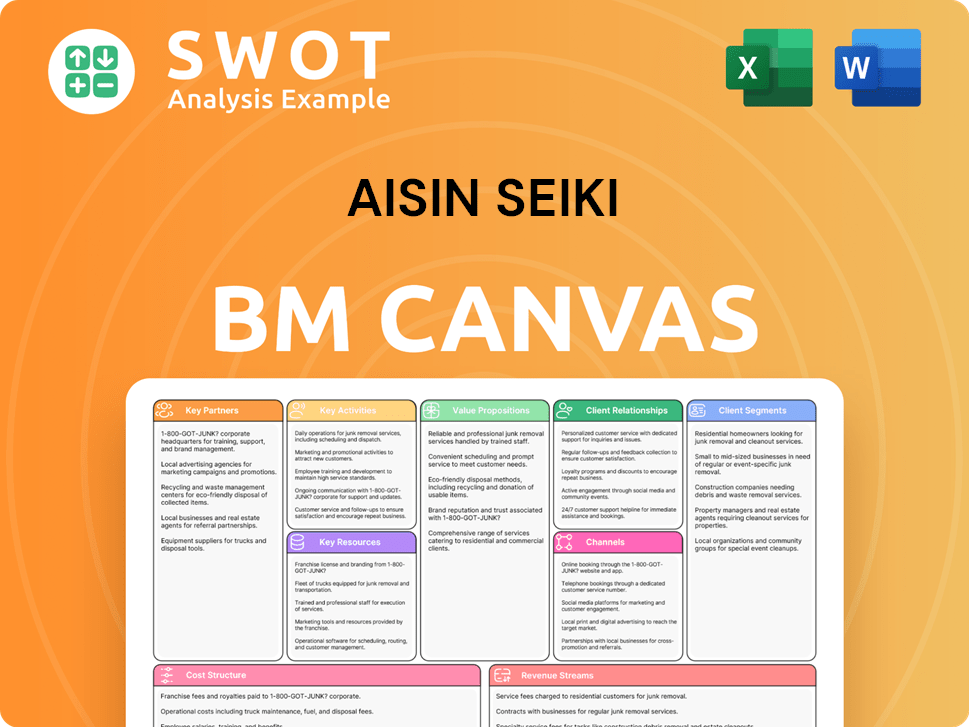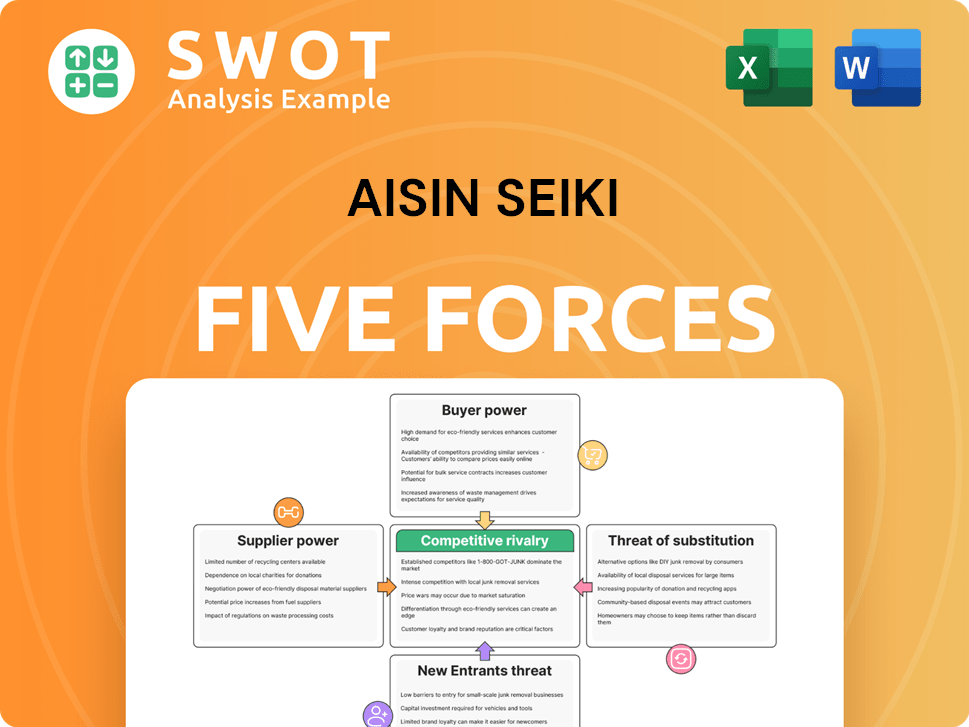Aisin Seiki Bundle
How Does Aisin Seiki Navigate the Cutthroat Automotive Industry?
The automotive industry is a battlefield, with companies constantly battling for market share and technological supremacy. Aisin Seiki, a key player in this arena, has built a global presence since its inception in 1949. But how does Aisin, a company born from Toyota, compete in this dynamic environment?

To truly understand Aisin Seiki's success, we must dissect its Aisin Seiki SWOT Analysis, its strategic positioning, and the competitive threats it faces. This deep dive into Aisin Seiki's competitive landscape will reveal its key rivals and its strategies for maintaining its significant market presence, offering a comprehensive Aisin Seiki market analysis. We'll explore Aisin Seiki's position in the automotive industry and its financial performance compared to competitors.
Where Does Aisin Seiki’ Stand in the Current Market?
Aisin Corporation, a key player in the automotive sector, holds a significant position within the global automotive components industry. The company is particularly strong in drivetrain and transmission systems. Aisin's diverse product range includes automatic and manual transmissions, components for hybrid and electric vehicles, brake systems, chassis parts, engine parts, and body components.
The company's market position is reinforced by its extensive global presence, with manufacturing and sales operations across Asia, North America, and Europe. This wide reach allows it to serve major automotive OEMs worldwide, catering to a broad spectrum of customers, from mass-market vehicle manufacturers to luxury brands. Aisin continuously adapts to industry trends, including a strong focus on electrification and autonomous driving technologies.
Its strategies involve substantial investment in developing components for electric vehicles (EVs) and hybrid electric vehicles (HEVs), reflecting a forward-thinking approach to emerging markets. Aisin's financial health remains robust, with a reported operating income of 152.9 billion JPY (approximately 1.02 billion USD) for the fiscal year ended March 31, 2024, demonstrating solid profitability compared to industry averages.
Aisin consistently ranks among the top global automotive suppliers. In 2023, Aisin reported revenue of approximately 4.5 trillion JPY (around 30 billion USD), highlighting its substantial scale within the industry. This revenue underscores its significant market share and its ability to compete effectively within the automotive sector.
Aisin's global footprint spans across Asia, North America, and Europe. The company serves major automotive OEMs worldwide, with a particularly strong position in the Japanese and Asian markets. Aisin is continuously expanding its footprint in emerging markets to capitalize on growth opportunities.
Aisin's product lines include automatic and manual transmissions, hybrid and electric vehicle components, brake systems, chassis parts, engine parts, and body components. This diverse portfolio allows the company to cater to a wide range of automotive needs. Aisin's focus on innovation and quality has helped it maintain a competitive edge.
For the fiscal year ended March 31, 2024, Aisin reported an operating income of 152.9 billion JPY (approximately 1.02 billion USD). This demonstrates solid profitability compared to industry averages. Aisin's financial stability supports its ongoing investments in research and development and expansion.
Aisin's competitive edge stems from its strong market position, diverse product portfolio, and global presence. It focuses on innovation, particularly in electrification and autonomous driving technologies. The company's strategies include strategic partnerships and investments to enhance its market position.
- Strong presence in the drivetrain and transmission segments.
- Significant investment in EV and HEV components.
- Robust financial health with consistent profitability.
- Extensive global manufacturing and sales network.
Aisin Seiki SWOT Analysis
- Complete SWOT Breakdown
- Fully Customizable
- Editable in Excel & Word
- Professional Formatting
- Investor-Ready Format

Who Are the Main Competitors Challenging Aisin Seiki?
The Aisin Seiki competitive landscape is shaped by intense rivalry within the automotive components sector. Several global players vie for market share across various product lines, from transmissions to braking systems. Understanding these competitors is crucial for assessing Aisin Seiki's market analysis and strategic positioning.
Aisin Seiki's industry presence is challenged by both direct and indirect competitors. These rivals employ diverse strategies, including technological innovation, global supply chain optimization, and aggressive pricing. This dynamic environment requires continuous adaptation and strategic foresight.
In the transmission and drivetrain segment, Aisin Seiki's competitors include ZF Friedrichshafen AG. ZF is a German multinational known for its advanced transmission systems, chassis technology, and active safety systems. Also, Magna International Inc., a Canadian global automotive supplier, is a strong competitor. Both companies challenge Aisin through extensive R&D and broad product offerings.
ZF's revenue in 2023 was approximately €46.6 billion, showcasing its significant scale and market presence. The company's focus on advanced technology and global reach makes it a formidable competitor in the transmission and drivetrain market.
Magna reported sales of $46.8 billion in 2023, reflecting its diversified product portfolio and strong position in the automotive supply chain. Its comprehensive offerings challenge Aisin across multiple segments.
Bosch's automotive sector sales reached €61.6 billion in 2023, demonstrating its strong presence in braking systems and other automotive technologies. This makes Bosch a key competitor in the braking systems market.
Continental's automotive technologies division generated sales of €36.3 billion in 2023. The company's focus on safety and braking systems makes it a significant competitor for Aisin in this area.
Denso's consolidated revenue for the fiscal year ending March 2024 was approximately ¥7.26 trillion (about $48 billion USD). Denso's strong presence in thermal systems, powertrain, and electrification presents significant competition.
Hyundai Mobis reported sales of approximately ₩59.2 trillion (around $43.8 billion USD) in 2023. Its aggressive pricing and expansion into new markets make it a formidable competitor.
In the braking systems market, Robert Bosch GmbH and Continental AG are key competitors. These companies compete on technological innovation and global supply chain efficiency. Furthermore, Denso Corporation and Hyundai Mobis present significant competition across various segments. These rivals challenge Aisin through aggressive pricing strategies and rapid technological adoption. For more insights, consider reading about the Growth Strategy of Aisin Seiki.
Several factors influence the competitive landscape for Aisin Seiki's automotive business.
- Technological Innovation: Continuous investment in R&D to develop advanced products.
- Global Supply Chain: Efficient and reliable supply chains to meet customer demands.
- Pricing Strategies: Competitive pricing to gain market share.
- Market Expansion: Entering new markets and expanding product offerings.
- Electric Vehicle Transition: Adapting to the shift towards EV components and technologies.
Aisin Seiki PESTLE Analysis
- Covers All 6 PESTLE Categories
- No Research Needed – Save Hours of Work
- Built by Experts, Trusted by Consultants
- Instant Download, Ready to Use
- 100% Editable, Fully Customizable

What Gives Aisin Seiki a Competitive Edge Over Its Rivals?
The competitive landscape for Aisin Corporation is shaped by its technological advancements, manufacturing prowess, and established customer relationships. Aisin's strong presence in the automotive sector is supported by its proprietary technologies, particularly in automatic transmissions and hybrid vehicle components. This positions the company favorably within the Aisin Seiki industry, allowing it to compete effectively with other major automotive suppliers.
Aisin's long-standing relationship with Toyota Motor Corporation provides a stable foundation for demand and collaborative development. However, Aisin also supplies to a wide array of other OEMs globally, diversifying its customer base and reducing its reliance on a single client. This approach is crucial in the dynamic Aisin Seiki automotive market, where adaptability and broad market reach are essential for sustained success.
Economies of scale derived from its large-scale production volumes across numerous facilities worldwide enable Aisin to achieve cost efficiencies. Its extensive global distribution network and localized manufacturing capabilities ensure timely delivery and responsiveness to regional market demands, enhancing its competitive edge. Aisin Seiki's market analysis reveals a company focused on innovation and strategic adaptation.
Aisin holds numerous patents in automatic transmissions and hybrid vehicle components. Its research and development investments focus on electrification, autonomous driving, and connected car technologies. This commitment to innovation is critical for maintaining a competitive edge in the Aisin Seiki competitive landscape.
Aisin's large-scale production volumes across numerous facilities worldwide enable cost efficiencies. Its global distribution network and localized manufacturing capabilities ensure timely delivery and responsiveness. These capabilities support its position within the Aisin Seiki automotive sector.
Aisin has a long-standing relationship with Toyota Motor Corporation, providing a stable foundation for demand. The company also supplies to a wide array of other OEMs globally, diversifying its customer base. These relationships are key to Aisin Seiki's market share analysis.
Aisin's global supply chain ensures timely delivery and responsiveness to regional market demands. This robust supply chain supports its manufacturing capabilities and customer relationships. Aisin's global presence and competition are significantly influenced by its supply chain efficiency.
Aisin's main competitive advantages include proprietary technologies, economies of scale, and strong customer relationships. Its commitment to research and development positions it at the forefront of automotive innovation. These factors contribute to Aisin Seiki's strategies for market dominance.
- Technological Leadership: Aisin's focus on advanced technologies like e-axles and integrated electric powertrain components.
- Manufacturing Efficiency: Large-scale production and global distribution networks.
- Customer Loyalty: Strong brand equity and long-standing relationships with major OEMs.
- Strategic Investments: Continuous investment in R&D, particularly in electrification and autonomous driving.
Aisin Seiki Business Model Canvas
- Complete 9-Block Business Model Canvas
- Effortlessly Communicate Your Business Strategy
- Investor-Ready BMC Format
- 100% Editable and Customizable
- Clear and Structured Layout

What Industry Trends Are Reshaping Aisin Seiki’s Competitive Landscape?
The automotive industry's trajectory is significantly shaped by the trends of electrification and autonomous driving, presenting both challenges and opportunities for companies like Aisin. The transition to electric vehicles (EVs) and the advancement of self-driving technologies are key drivers of change. Aisin's strategic positioning and adaptation to these shifts will be crucial in determining its future success within the Aisin Seiki competitive landscape.
Several factors could impact Aisin's market position, including intensified competition from new EV component manufacturers, economic downturns, and supply chain disruptions. However, Aisin is also poised to capitalize on growth opportunities in emerging markets and through innovations in mobility services, requiring strategic investments and partnerships to maintain its competitive edge. Examining the Aisin Seiki market analysis reveals the importance of adapting to these evolving market dynamics.
Electrification is a major trend, with battery electric vehicles (BEVs), hybrid electric vehicles (HEVs), and fuel cell electric vehicles (FCEVs) driving change. Autonomous driving technologies are also advancing, increasing demand for sensors and software. Regulatory changes, such as stricter emissions standards, further accelerate the adoption of electric and hybrid technologies. The shift towards EVs is evident, with global EV sales expected to reach over 14 million units in 2024, according to the International Energy Agency (IEA).
Intensified competition from new EV component manufacturers, particularly from China, poses a significant threat. Economic downturns and supply chain disruptions, as experienced in recent years, also present ongoing challenges. The potential for automotive OEMs to insource component production could further impact Aisin's market share. Supply chain issues have caused production delays, with the automotive industry experiencing a -10% decrease in production volume in 2022 due to these disruptions.
Significant growth opportunities exist in emerging markets, where vehicle ownership is still expanding. The development of innovative solutions for mobility services also presents new avenues for growth. Strategic partnerships and continuous R&D investments in cutting-edge technologies are essential. The global automotive market is projected to reach $3.3 trillion by 2028, offering substantial expansion potential.
Aisin is deploying strategies such as strategic partnerships to navigate these trends. They are also investing in continuous R&D in cutting-edge technologies. Diversification into non-automotive sectors, like energy management systems, is another key strategy. Aisin’s focus on R&D is reflected in its annual investment, which totaled over $1.5 billion in 2023.
Understanding the Aisin Seiki automotive sector requires a focus on key areas for future success. Addressing the challenges and capitalizing on opportunities will be vital for Aisin's performance.
- Strategic partnerships to leverage expertise and resources.
- Continuous investment in R&D to develop innovative technologies.
- Diversification into non-automotive sectors to reduce dependence on the automotive market.
- Adaptation to changing market demands, including the shift towards EVs and autonomous driving.
For a deeper understanding of Aisin's strategic approach and growth plans, consider reading the Growth Strategy of Aisin Seiki.
Aisin Seiki Porter's Five Forces Analysis
- Covers All 5 Competitive Forces in Detail
- Structured for Consultants, Students, and Founders
- 100% Editable in Microsoft Word & Excel
- Instant Digital Download – Use Immediately
- Compatible with Mac & PC – Fully Unlocked

Related Blogs
- What are Mission Vision & Core Values of Aisin Seiki Company?
- What is Growth Strategy and Future Prospects of Aisin Seiki Company?
- How Does Aisin Seiki Company Work?
- What is Sales and Marketing Strategy of Aisin Seiki Company?
- What is Brief History of Aisin Seiki Company?
- Who Owns Aisin Seiki Company?
- What is Customer Demographics and Target Market of Aisin Seiki Company?
Disclaimer
All information, articles, and product details provided on this website are for general informational and educational purposes only. We do not claim any ownership over, nor do we intend to infringe upon, any trademarks, copyrights, logos, brand names, or other intellectual property mentioned or depicted on this site. Such intellectual property remains the property of its respective owners, and any references here are made solely for identification or informational purposes, without implying any affiliation, endorsement, or partnership.
We make no representations or warranties, express or implied, regarding the accuracy, completeness, or suitability of any content or products presented. Nothing on this website should be construed as legal, tax, investment, financial, medical, or other professional advice. In addition, no part of this site—including articles or product references—constitutes a solicitation, recommendation, endorsement, advertisement, or offer to buy or sell any securities, franchises, or other financial instruments, particularly in jurisdictions where such activity would be unlawful.
All content is of a general nature and may not address the specific circumstances of any individual or entity. It is not a substitute for professional advice or services. Any actions you take based on the information provided here are strictly at your own risk. You accept full responsibility for any decisions or outcomes arising from your use of this website and agree to release us from any liability in connection with your use of, or reliance upon, the content or products found herein.